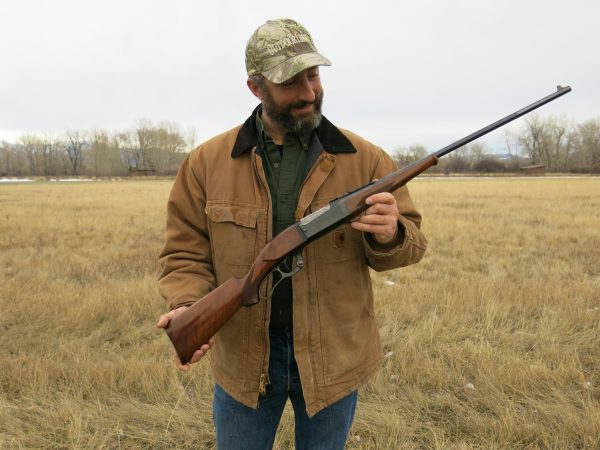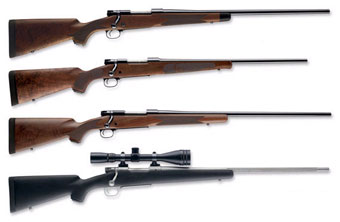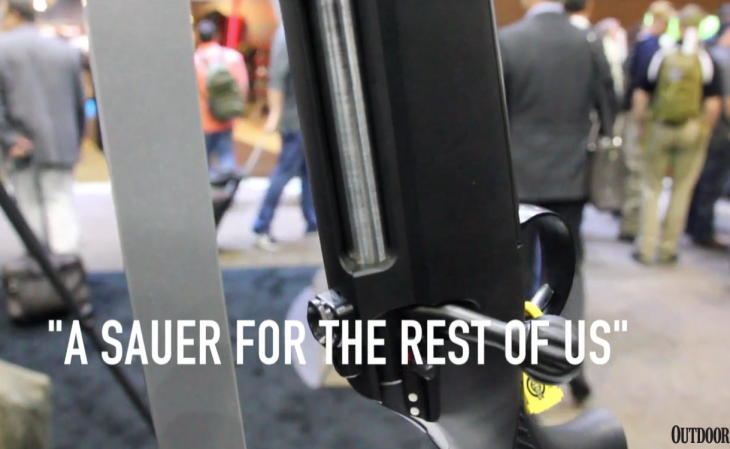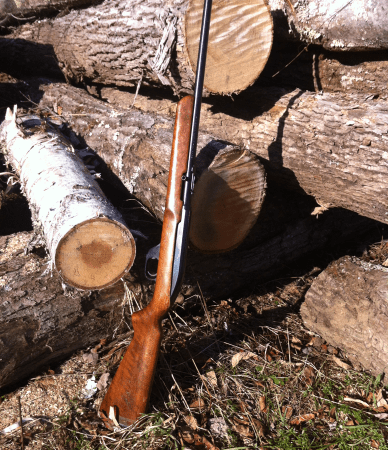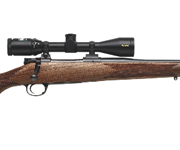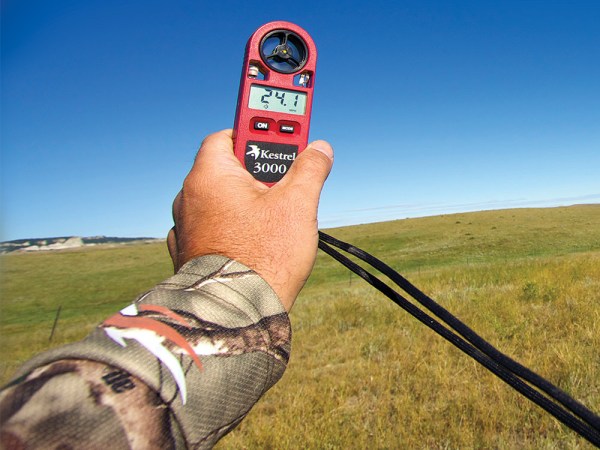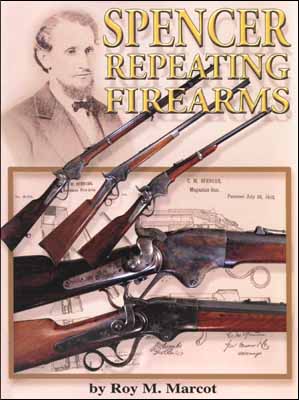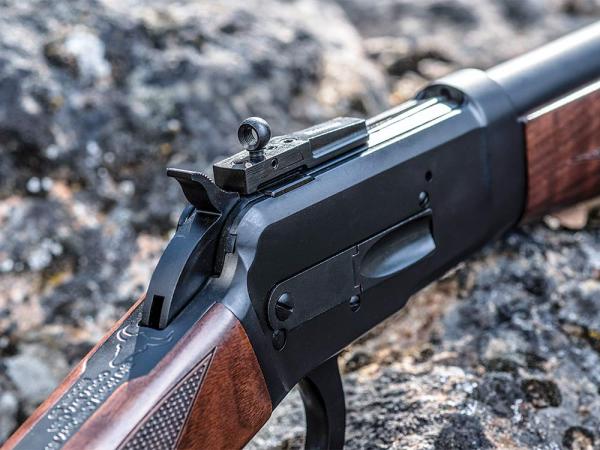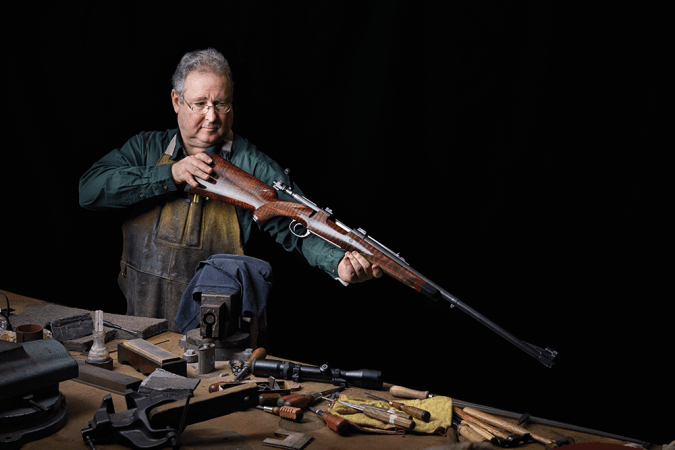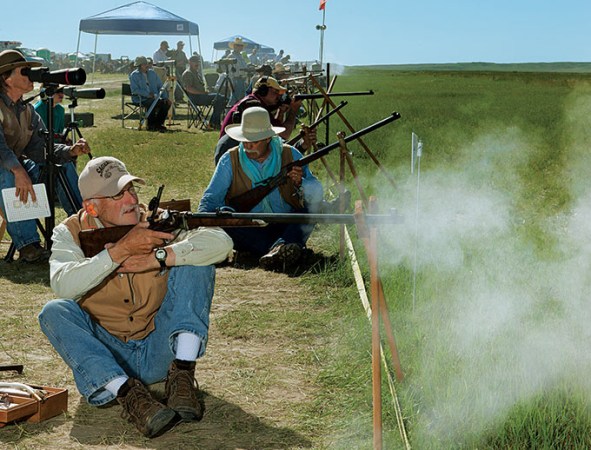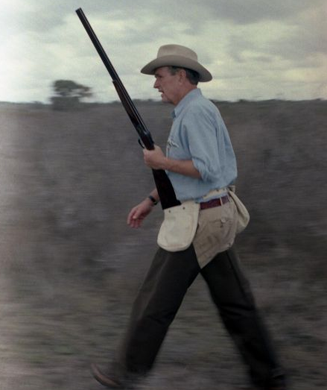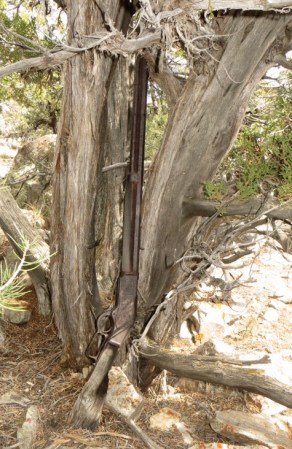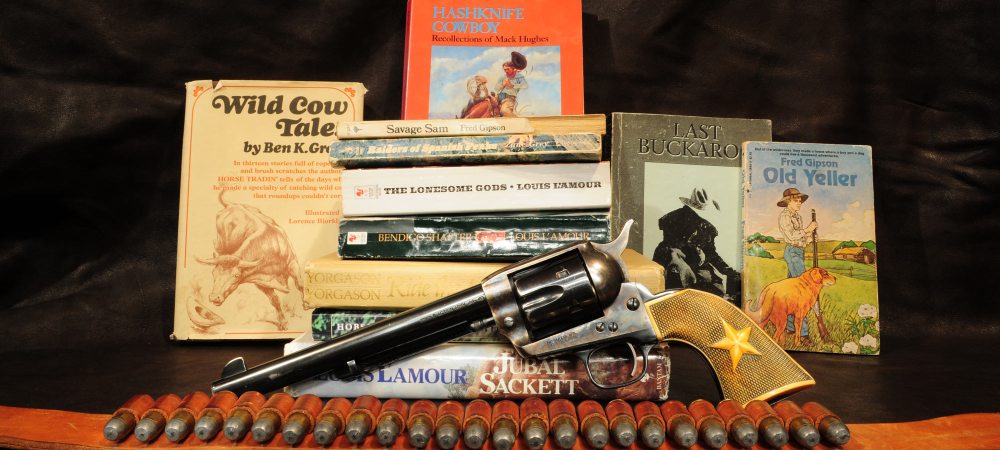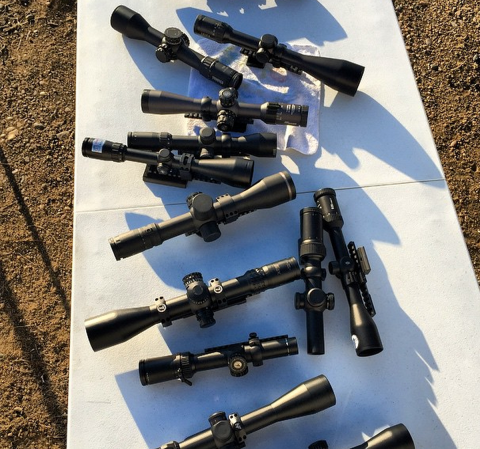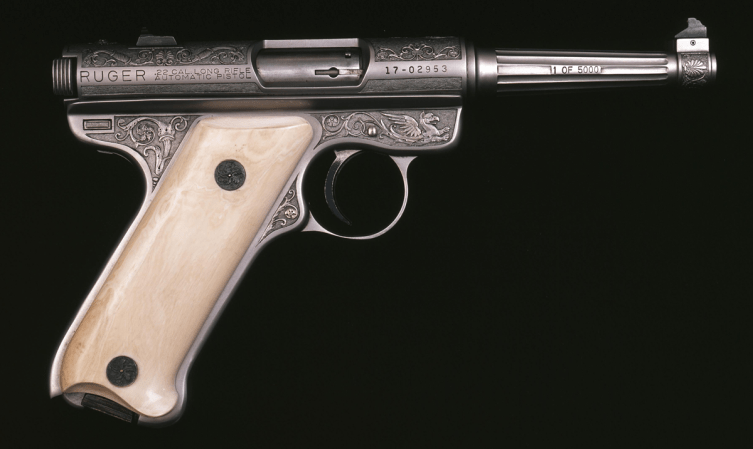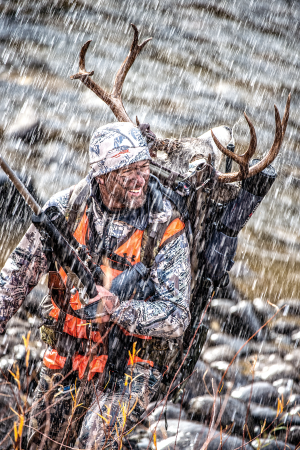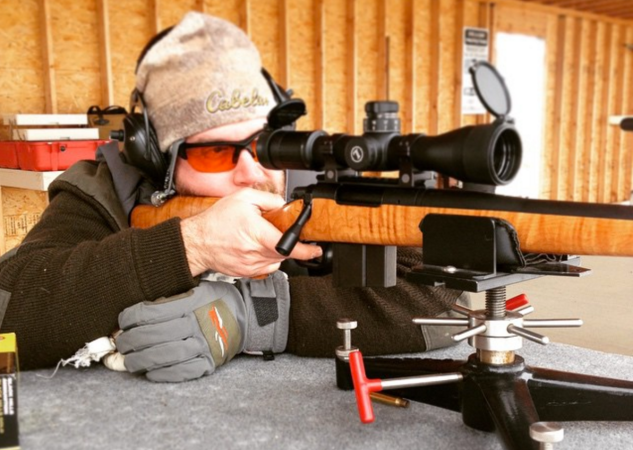We may earn revenue from the products available on this page and participate in affiliate programs. Learn More ›
In the early years of the twentieth century whitetail populations were making a comeback and deer hunting was a growing sport. Lever action rifles ruled the woods for at least the first half of the century and beyond. Even in my early years of hunting in the late sixties, lever actions seemed to fill the gun rack in every deer camp. The most popular was the Winchester Model 94, usually in .30-30, and this rifle dominated the deer woods.
While the 94 was the gun for the masses, the gun guys, the hunters who “knew stuff” had a different pick. The Savage Model 99 rifle was often their choice. While the tube magazine on the Winchester and Marlin lever actions limited the rifles to use with blunt nose bullets, with its rotary box magazine the Savage 1899 could use pointed bullets for a ballistic advantage. It was also strong enough to handle powerful cartridges using that newfangled smokeless powder.
The lever action Model 99 featured an internal hammer and many advanced features like a cocking indicator and even a counter to show the number of cartridges in the magazine. It was simply a more sophisticated design than the other lever actions. The introduction of the .250 Savage cartridge for the Model 1899 in 1915 ushered a new world of deer cartridges. At the time most cartridges barely broke the 2,000 ft/s barrier, but this one hit 3,000 ft/s with an 87-grain bullet. The savviest hunters recognized the advantage over the big, slow, hard kicking, straight walled black powder cartridges that were still in vogue at that time.
Five years later in 1920, Savage changed the name to the Model 99 and introduced the .300 Savage, a cartridge that at the time matched the ballistics of the .30-06. With these advanced cartridges the Savage Model 99 rifle became the thinking man’s deer rifle.
Prior to WWI bolt action rifles were almost unheard of for deer hunting and the Savage Model 1899 lever action rifle led the industry in innovation and performance. Even after the war when bolt action sporting rifles began to emerge into the market, the Savage remained one of the most popular hunting rifles on earth.
So how did this rifle come to be? As with many of our great firearms in history it was because of one visionary, Arthur William Savage.
An Inventor is Born
Savage was born in Kingston, Jamaica on May 13, 1857. He received an education in the United States and in England, which was probably designed to have him follow in his father’s footsteps and become a government bureaucrat.
But Savage wanted adventure, so as soon as they handed him his diploma he hightailed it for Australia to look for black opals and interesting experiences, as Teddy Roosevelt called them.
At some point he was captured by aborigines and held captive for a year. One version of the story says that his captors demanded a ransom, but his family refused to pay. The historian was unable to provide details as to why, but I suspect that Christmas dinners with his family were a bit tense after his escape.
Savage explored the wild Australian interior in a covered wagon. Later he became the owner of the largest cattle ranch down under. He married Annie Bryant while there and eventually had four sons and four daughters. After eleven years in Australia, Savage returned to Jamaica at the age of 34 to grow coffee.
Savage loved firearms and machinery. He was always tinkering on new ideas. He improved the British service rifle. Among his inventions was a torpedo that he sold to the government of Brazil. He also developed the recoilless rifle and the detachable rifle magazine. Savage soon recognized that the future was in America, not Jamaica.
He traveled to New York where he took a job managing the Utica Belt Line railroad in Utica, NY. In his spare time he developed a hammerless, lever-action rifle. He patented the design in 1893 with an unwavering belief that this gun would lead the way into a new world of firearms. With a few investors, he founded Savage Arms in 1894.
It took courage to open a gun company in a field that was dominated by Winchester, Remington, and Colt, but Savage recognized that the newly invented smokeless powder was about to change the rifle world and that the low-pressure, big-bore, rifle cartridges were going to become obsolete. Europe was already using smokeless powder in some cartridges and here in America in 1892, the Army had adopted the .30-40 Krag as our first smokeless powder cartridge. Some sporting rifles were chambered for this new cartridge and Savage could see the future was with small bore, high velocity smokeless powder cartridges.
The first Savage rifle was the Model 1892, although it never got into production. Savage built it to compete for a military contract, which ultimately went to the .30-40 Krag bolt action. Savage continued to work on the design and it evolved into the Model 1895. That rifle won a contract to supply rifles for the New York National Guard. But politics prevailed, as it always has and probably always will in NY, so the contract was cancelled. The poor soldiers were sent off to fight in the Spanish-American war with obsolete single-shot trapdoor Springfield rifles.
With the Model 1895 rifle Savage also introduced a new cartridge, the .303 Savage, a bottle-necked, .30-caliber (.311 diameter bullet) cartridge designed for smokeless powder. Savage created the cartridge with a military contract in mind, but that never developed so he turned to the sporting rifle market.
The Model 1895 rifle, which was reported to have been built by Marlin Firearms Company for Savage, was revolutionary as it was designed to use modern, bottle-necked, smokeless powder cartridges and could handle pointed bullets. The new, smaller .303 Savage cartridge had to compete with the physically larger and more popular cartridges of the day, like the .45-70 Government. At the time the public still equated killing power with physical size and convincing them that technology would allow this diminutive cartridge to perform better than those claiming brute size as their biggest asset would define the struggle for success.
Proving he understood marketing as well as design, Savage started running testimonials in his catalog about the effectiveness of the new cartridge. In those days the catalog not only displayed the products, but it was a source of information for hunters and gun owners in the era before internet, television, or radio. Savage recognized that and ran first person accounts of one-shot kills with the .303 Savage on moose, deer, caribou, sheep and even grizzly bears. But the clincher was from an Alaska resident who killed a whale with a single shot from the .303 Savage.
The Model 1895 evolved into the Model 1899 rifle. That went on to become of the most successful hunting rifles in history. On March 22, 1960 Savage presented the NRA with the one millionth rifle made. No one is quite sure about the total sales number, but it would continue to be made for 38 more years.
A little known fact is that Savage did much of the development work on his early rifles using the machinery at the Remington factory. It’s said that he offered his lever action design to Remington.
Remington and Winchester were owned by the same company at the time and it’s thought that Remington was being locked out of the lever action market by upper management. Winchester didn’t want the competition. It’s what led to Remington developing their semi-auto and pump action line of hunting rifles.
But if you think about it, if those in charge had a little more foresight and had allowed Remington to dip a toe into the lever action market the Model 99 would have had the Remington name on it and Savage Arms might never have existed.
Savage was a restless soul and in 1904 he sold his interest in the company to a group of businessmen and headed west to California. There he started the Savage Tire Company, which grew to employ as many as 2,000 people at one time. It’s said that he invented the radial tire. Later he would have citrus groves, drill for oil and mine for gold. He died in 1938 at the age of 81. His was a life well lived and his lasting legacy would be the Model 99 rifle.
The Savage Design
Savage Arms of course continued on without Arthur Savage and by the 1920s it became the largest firearms company in the free world.
In what was probably the start of a Savage tradition, the Model 1899 and 99 rifles were made in a dizzying number of models and configurations. At one time there were more than 700 SKUs of the Savage Model 110 rifle. I am not sure the Model 99 matched that, but it sure tried. Entire books have been written about the various models of this rifle.
There were octagon and half octagon barrels. Carbines and rifles with barrel lengths from 20 inches to 26 inches. The military musket had a 28-inch barrel. The 1895 had a 30-inch tube. There was even a model with a .410 shotgun barrel. Some had a saddle ring and others had deluxe wood. Still others had deluxe wood and fancy engraving. Some rifles had cut checkering and many had no checkering at all. In later years as they tried to cut production costs and ultimately ruined the rifle, some of those stocks had pressed in rifling. Some 99s had straight levers and grips, but most had curved levers with a pistol grip. The forends ranged from Schnabel to a plane Jane straight forend. Some rifles were take-down and others were not. Some came with tang mounted peep sights and others with a very innovative scope mount. It wasn’t until 1950 that Savage started drilling and tapping the rifles at the factory for scope mounting. Some carbine models had a barrel band, but most models did not. The rotary magazine was at some point modified to remove the counting window and the traditional brass was replaced with steel. In 1965 they introduced the “C” model which featured a detachable “clip” magazine. (Yes, they called it a clip. No matter what they tell you on the internet, “clip” was a commonly used term to describe removable magazines in sporting rifles for decades.)
The Savage Model 99 features a hammerless design with a much faster lock time than a traditional lever action. The lever is connected to the breech bolt by a long, wide, curving piece of metal. This gives the rifle a distinctive profile when the action is open. The breech block locks into the action as the lever is closed creating a strong action design that is suitable to modern high-pressure cartridges. While it’s not often noted, the Model 99 action is a controlled round feed design. That means that the extractor captures the cartridge as it exits the magazine and holds it against the bolt face during its travel into the rifle’s chamber. There is a cocking indicator in the form of a pin that sticks out of the top of the action when the gun is cocked and recedes inside when it is not.
The stock is two pieces with separate forend and buttstock. The bottom of the metal action is rounded which makes this rifle a delight to carry in your hand.
The safety is a small catch on the right side of the lever. Pushed forward it locks the lever shut and prevents the rifle from firing. Pulled back it is in the fire position. This is opposite of the more common safeties seen on modern rifles where back is safe and forward is fire. Shooters were smart enough to know the difference back then. Sometime in the mid-sixties a top-tang shotgun style safety was added on some models, but the traditional style lever locking safety remained more popular.
Cartridges for the 99
The .303 Savage was the first cartridge introduced in 1895. It was more or less a ballistic twin to the .30-30 introduced the same year. These were the first sporting cartridges designed for smokeless powder and it’s debatable which one was first. The .303 Savage is a handloading-only deal now, but I have always wanted one just because. My friend Lane Pearce just bought one and called to gloat. I hate him.
The .22 Savage High Power was next. It was designed by Charles Newton and introduced in the Model 99 in 1912. It was based on the .25-35 Winchester cartridge necked down to take a .228-diameter bullet. With a 70 grain bullet and a muzzle velocity of 2,800 ft/s it was marketed for big game. In fact, Savage ran testimonials of foolish feats like a 400-pound Tiger taken by Reverend H. R. Caldwell with .22 Savage Hi-Power. Or W.M.D. Bell, the demigod of inadequate rifle cartridges, shooting a Cape buffalo with one. I am sure that probably sold some guns and no doubt got some people killed. But, the truth won out and the cartridge lost favor. Not saying I don’t want one; I do, but not for hunting big game.
Next came the Newton designed .250-3000, which is simply called the .250 Savage today. Newton designed it with a 100 grain bullet, but the marketing folks at Savage wanted that “3000” in the name and reduced the bullet weight to 87 grains to achieve that goal. Terminal performance was erratic until the ammo companies finally listened to Newton and made ammo with a 100 grain bullet. Sadly, he never saw it come to fruition as he died just before the ammo was introduced.
The .300 Savage is the flagship. It was 1920 and the war was over. The doughboys coming home had seen the .30-06 in action and they were impressed. Savage knew that the cartridge would not work in the Model 99, so they created one that would. They shortened the .30-06 case, made a short neck and a sharp shoulder so they could pack all the powder possible into the case. The result was a 150-grain bullet at 2,700 ft/s. That matched the sporting load for the .30-06 at the time. (The velocity was later increased in the .30-06 to 2,900 ft/s.) The .300 Savage soon became one of the most popular hunting cartridges and many gun makers other than Savage chambered it in their rifles. In addition to my Savage Model 99 I have a Remington Model 760 pump action and a Remington Model 722 bolt action rifle in .300 Savage, two of the more popular rifles in that cartridge.
When the military was looking for a new short action cartridge they looked at the .300 Savage. In the end they modified the case to create the 7.62 NATO which was introduced to the sporting world as the .308 Winchester. The pity is that the .308 killed off the .300 Savage. It wasn’t long before the .308 was outselling the .300 even in the Model 99. I don’t think any major rifle maker offers the .300 Savage today. Not even Savage.
The Model 99 has been chambered for a lot of cartridges over its life span. See the list below. In addition to the .303 and .22 HP my bucket list includes a .358 Winchester and the very rare .284 Winchester. The trouble is, the folks I have encountered selling them are asking prices that make a gun writer question his career choices.
The cartridges chambered in the Savage Model 1899 and Savage Model 99 over the years.
- .303 Savage
- .32-40 Winchester
- .300 Savage
- .30-30 Winchester
- .25-35 Winchester
- .250 Savage
- .22 Savage Hi-Power
- .22-250 Remington
- .243 Winchester
- .308 Winchester
- .358 Winchester
- 7mm-08 Remington
- .284 Winchester
- .38-55 Winchester
- .375 Winchester
- .410 shotgun
Model Numbers
The early guns were not clearly marked with model information and trying to figure out which model a gun is can drive a Baptist Deacon to a hard drink. Mine is a 99-EG as far as I can figure out. It was made in 1936 and has smooth, non-checkered wood, which adds a premium to the value. But, it hardly matters now. At some point the gun was drilled and tapped for a scope, which detracts from the collector’s value but adds to the “usability” of the rifle. There is a Weaver 1.5-4.5 Wide Angle scope on it with Weaver mounts. This TV screen scope was introduced in 1973 to compete with the Redfield Widefield scopes and it makes me think it was added to the rifle in the mid-seventies. Sling swivels have also been added and at some point a skilled craftsman repaired a cracked stock. Which means this is no collector’s rifle. That suits me fine; I bought it to hunt with, just as Arthur Savage intended.
My rifle has what I think is the 1926 style front sight ramp that is integral with the barrel. I have to wonder what that would cost to reproduce today. The rifle sold in 1939 for $47.00. So I am guessing that when mine was made three years earlier it was maybe $45.00? That barely buys a box of ammo today.
It was a sad day in 1998 when I got a call from the marketing director of Savage to inform me that the Model 99 was being discontinued. I had a gun on loan for an article which with that call changed its focus. The gun was shabbily made and unlike the elegant 99s of the past, it felt like a dead fence post in my hands. The truth is, if this is all they could produce, it was time to stop. I should have bought it at the very good price he offered, but I didn’t. I returned it to Savage and mourned the end of a dynasty.
Will the Model 99 Ever Make a Comeback?
Savage experienced some hard times shortly after the Model 99 was dropped. Ron Colburn took over the company and made a drastic move to drop every single product except the Model 110. Everybody said he was crazy, but he saved the company. Savage today is healthy, vibrant, and is building good guns.
Once Ron’s brilliance became apparent and Savage began growing and prospering we all asked when he would bring back the Model 99.
“Never,” he said with his Irish brogue. “It’s just too expensive to make because it requires a lot of hand fitting of parts. Besides, the market isn’t there anymore. I wish it wasn’t true, I dearly love the rifle, but that’s reality.”
Ron never wavered from that until the day he retired.
The same question came up with the current owners during a press conference in early 2020 and the Savage folks provided the same answer almost by rote.
Most recently I contacted Jessica Treglia, Sr. Brand Manager at Savage Arms. Here is what she said:
“We have no current plans to bring back the M99. The cost to manufacture this gun would push the price above $1500 and would not be well received by our customers and thus the volume would not cover the cost to tool up to make the rifle. That said, a lever action is not in our current plan but is on the long term one. It will not, however, be a M99.”
I am of the belief that this “conventional” wisdom is wrong. Much has changed since the Model 99 stopped production. The “high cost due to the labor of hand fitting the parts” is no longer an excuse.
With modern computer controlled machinery and new manufacturing techniques Savage can reduce greatly the labor cost. I am of the belief that the rifle could be made and sold at a price the market will accept.
The question is simply that, the market. Is it there to support a return of the rifle? Sadly, I think the answer is no. The world has moved on. There is a bit of a nostalgic return of interest in lever-action rifles and surprisingly some movement to using them as self-defense rifles in states with harsh gun laws. But, that is aimed at the more traditional lever actions. Sure, a lot of the diehard gun guys would buy a new Model 99 if it was properly made. But, sadly, there just are not enough of us to justify the cost of bringing it back.
Outdoor Life is dedicated to covering safe and responsible gun ownership for hunting, recreation, and personal protection. We participate in affiliate advertising programs only with trusted online retailers in the firearms space. If you purchase a firearm using the links in this story, we may earn commission.
